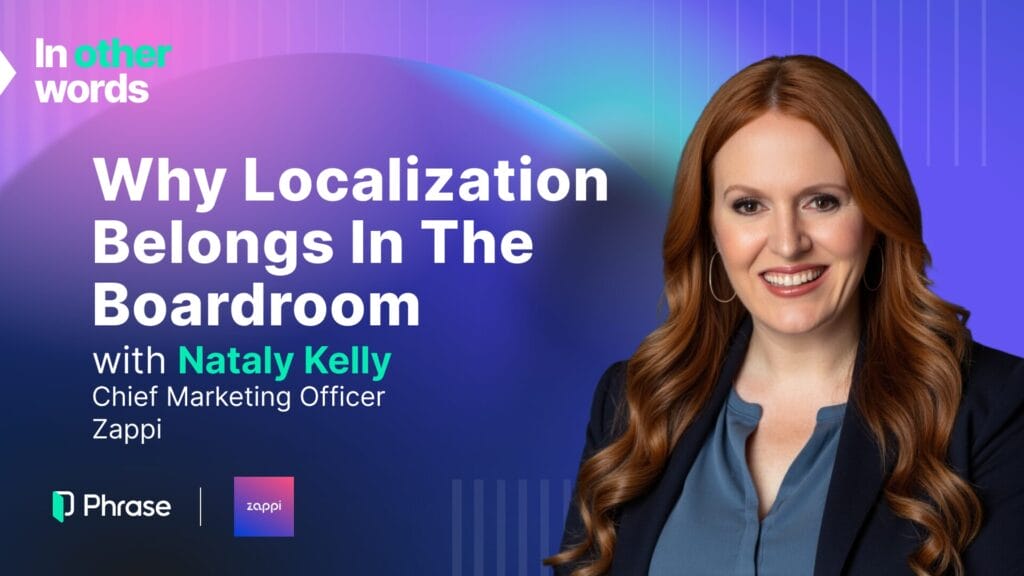How human-AI collaboration is powering authentic engagement at scale
“AI is just a tool.” What started as a reassuring and pragmatic phrase used partly to dampen media hype has arguably become a platitude.
The debate about how artificial intelligence will change the workforce is not dissimilar to late ‘90s discussions about the internet. In truth, arguing about the long-term impact of tech is a modern-day parlour game. What’s really of interest to businesses is what AI can do now and in the short to medium term.
In this article, we’ll look at the impact of AI in the tech industry, particularly for SaaS businesses, including:
- how it is shaping product development, marketing and customer experiences;
- it’s role as a decision-making partner across sectors;
- the potential of large language models (LLMs) to drive consistency and authenticity;
- how tech companies are using AI-powered localization to personalize experiences worldwide.
AI as business multiplier in tech
An instructive place to start is to look at how some of the big tech platforms market themselves, to see just how central AI now is to their propositions:
- GitHub’s enterprise offering, for example, is “the AI–powered developer platform,” and promises to unlock “innovation at scale with AI–driven software development.”
- Google the term ‘Salesforce’ and you may well be served a search ad for “The World’s #1 AI CRM Software”.
- At the time of writing, Adobe’s hero homepage banner advertises its Firefly app as “The ultimate creative AI solution”.
Whilst it’s nothing new to see AI front and center in these kinds of B2B tech marketing efforts, the current AI boom is very different to the last. In 2017, during the last AI summer, all sorts of SaaS businesses trumpeted their AI credentials, but a lot of the functionality on offer was some form of predictive analytics powered by machine learning.
Marketing and sales software, for example, added a skein of intelligence to its automation functionality – helping with lead scoring, understanding propensity to buy, and determining who might currently be in-market for a particular product.
Elsewhere, in customer service, there were automated chatbots which, if they went beyond rigid decision trees, would use NLP (natural language processing) tech of the time to identify a limited set of common customer requests. This allowed a human representative to check or automate a canned response if a certain confidence level was achieved.
Zendesk empowers new connections through global scalability and superior localization
These innovations were not insignificant of course, but the tech of 2017 was only scratching at the surface of the possibilities of AI. Trailblazers were those using machine learning to prioritize their marketing spend and to automate next-best-action decision making. Others at the forefront of NLP were doing product categorization or optimizing copy – see the development of CRM companies like Phrasee (now Jacquard), which helped to pioneer AI copywriting.
Fast forward to today and the landscape is very different. Movable Ink, a CRM company that specializes in personalization of email and mobile messages, describes its newest SaaS platform, Da Vinci, launched in 2023, as “a unified suite of marketing AI models that optimize every customer experience for increased lifetime value.”
This “ensemble approach” shows how the predictive AI models that were being explored at the cutting edge in 2017 have now been integrated into every corner of SaaS products, along with some generative models. In the case of Movable Ink, the platform utilizes machine learning, deep learning, and generative AI for a range of functionality including:
- Prediction – using customer behaviors to predict e.g. the ideal frequency, creative or send-time of messaging for every individual.
- Vision – for classifying content, allowing marketers to understand what visual elements within messages lead to success.
- Generation – to create subject lines or adapt imagery.
- Insights – detailing customer tastes and engagement, in order to guide the campaign and content planning.
Generative AI as the keystone of institutional knowledge
AI is now at the center of personalization, automation and localization, helping companies (including SaaS businesses) to scale. And consumers, too, are using AI-powered experiences every day in many new ways.
One example is the inconspicuous camera in the supermarket fruit and veg scales which ‘sees’ and identifies the item a customer wants to weigh (reducing the need for staff assistance), or the handy summarization of customer reviews on Amazon product pages.
It’s this advance in LLMs and computer vision, beginning in the 2020s with the releases of DALL-E and ChatGPT, that has led to more and more use cases, as tech companies make the most of easy access to powerful models.
Sticking with CRM, we can get an idea of how generative AI in particular is changing SaaS products. Salesforce offers solutions that can use customer data to “bring conversational AI to any workflow, user, department and industry”. That means both customers and employees can engage with an agent grounded in relevant data. Customer support teams can then begin to build a knowledge base using this technology, with summarized case resolutions.
Elsewhere, McKinsey gives us a specific example of how LLMs and RAG methodology (retrieval augmented generation) allow businesses to create a font of institutional knowledge. The consulting firm’s generative AI platform, named Lilli, was reportedly* trained on 100 years of McKinsey intellectual property. The firm stated that almost three quarters of staff are actively using the tool, with a resulting 30% time-saving on searching for and synthesizing knowledge.
The benefits of using AI for institutional knowledge in this way are compound – the efficiency of individuals can be improved whilst ensuring greater consistency across a business too. At the Festival of Marketing in 2023, Cathrine Levandowski, Global Head of Operations at Quintessentially, a lifestyle group known for its concierge service, explained how the business had decided to use generative AI when creating a member app portal on Salesforce.
The simple idea was to write marketing content for the portal in a way that could be processed byAI and shared from Marketing Cloud to Service Cloud. This approach would guard against a “disconnect” between teams, as customer service teams could then be guided on how to communicate with customers in a way consistent with the company’s marketing comms, and vice versa.
Combining both predictive and generative AI, businesses could also see benefits in adapting content for new audiences.
*Link is to paywalled content.
The era of human-AI collaboration in software
Given that many SaaS platforms now routinely use generative AI, debate about the future of SaaS has intensified. As in the Salesforce example – this is largely because of the potential that agents show to circumvent the need for a more complex user interface (UI), or perhaps even circumvent the business logic with which each SaaS product aims to create a competitive advantage.
The near future for SaaS, therefore, may be akin to how GitHub Copilot describes its ‘agent mode’, which helps users improve their work by “analyzing code, proposing edits, running tests, and validating results”.
Microsoft CEO Satya Nadella caused a stir with apposite comments about the future of SaaS in late 2024 on the BG2 podcast. Host Bill Gurley asked Nadella about whether startups using an AI-first approach to business applications may be able to sidestep the complexity of legacy SaaS UIs – think using an agent instead of your traditionally messy CRM interface.
Nadella postulated that an agent era could spell the end for business applications that are “essentially CRUD (create, read, update, delete) databases with a bunch of business logic,” because agents are “going to update multiple databases, and all the logic will be in the AI tier, so to speak”.
This is similar to the idea, discussed widely over the last five years, that SaaS platforms will move from being ‘systems of record’ to ‘systems of intelligence’. Here’s Google’s explanation of the latter from a December 2023 article authored by Google Cloud AI execs Kawal Gandhi and Philip Moyer: “Rather than requiring users to know how to extract insights from the data, the system of intelligence is designed to identify, ask questions, and provide insights in a way that is easy for all users to understand.”
SaaS has traditionally been a system of record defined by cloud-based data storage and ease of use on the frontend, with a human as the ultimate decision maker. As AI starts to take a share of the decisions, too, as well as playing an active role in keeping the data in line (clean and integrated) then Nadella’s vision of applications freed from their own specific data standards and workflows comes into view.
What solutions such as GitHub Copilot, Adobe Firefly, Salesforce’s Agentforce and McKinsey’s Lilli have in common is simple – they each create a form of collaboration between AI and user. Humans have not been removed from the picture, merely augmented.
Just as tech has always done, AI has made many SaaS products simpler to use, opening up more opportunities for the non-expert coders, non-designers, non-data analysts and non-archivists. Likewise, AI has made those already expert in these professions potentially more efficient.
Referred to by many as ‘workflow automation’, the ability to get rid of repetitive or onerous tasks has always been one of the goals of technology innovation. Modern AI may even go as far as to disintermediate some SaaS tools entirely.
This concept is outlined by Scott Brinker and Fran Riemersma in their Martech for 2025 report, where the authors refer to ‘service-as-a-software’ (SaaS with the S’s reversed). The idea is that AI can provide immediate outcomes where once a tool would have been used to the same end, such as in the creation of synthetic data for market research (instead of polling people and collating results).
Scaling SaaS through AI-driven localization
Localization is one area seeing greatly improved efficiency via workflow automation and LLMs, hand in glove with human insight and decision making.
SaaS and cloud services that sell in many international markets must ensure that they adapt seamlessly to many different languages and cultures. One category of tech company for whom this is particularly pertinent is the streamers.
In March 2025, Prime Video began trialling a new AI-assisted dubbing tool on a small selection of movies and series (the likes of YouTube and Netflix have also experimented with auto-dubbing). Amazon’s press release was at pains to point out that this pilot is “a hybrid approach to dubbing in which localization professionals collaborate with AI to ensure quality control”.
This AI-assisted dubbing and subtitling, when combined with Prime Video’s personalized recommendations, X-Ray recaps (AI-powered summaries of shows), and of course its culturally attuned approach to content production – all leads to a strategy intended to provide a viewer, wherever they are, with something they enjoy paying for every 30 days.
Phrase Studio: Bring action into the heart of your localization workflow

Upload any recording, or capture live conversations, and instantly generate high-accuracy transcripts, localized subtitles, or natural-sounding voiceovers in over 100 languages.
Phrase Studio doesn’t stop at conversion. Using AI, it identifies key themes in your content, generates clear summaries, and uncovers the insights that help teams move faster – turning spoken content into structured, searchable, and global-ready communication. From leadership keynotes and training sessions to interviews, webinars, and podcasts, Phrase Studio transforms voice into a resource your entire business can mobilize. Fast, secure, and ready to localize.
Another example comes from the world of ecommerce, where market-leading platform Shopify has offered its Translate & Adapt app since 2022. The app auto translates Shopify stores and also allows for manual translation and review, with its app page highlighting the importance of localization in boosting traffic, improving SEO and building trust (not to mention the effect on conversion and abandonment rates).
Phrase’s Auto Adapt was created to allow any business, including SaaS and tech firms, to fine-tune their content in a similar way. It allows companies to:
- tailor messaging based on audience-specific factors, such as age;
- ensure translations align with brand tone of voice and style guidelines;
- craft culturally relevant marketing campaigns;
- adjust content to meet local regulations;
- create local, authentic content.
When integrated with customer support software such as Zendesk, the Phrase Platform can quickly bring competitive advantage, translating tickets in real-time to enhance productivity and improve customer satisfaction. Knowledge base management can then be undertaken through Phrase’s translation management system, with integrated workflows meaning that any help center update is automatically pushed for translation and editing.
The AI-human double act
So, back to the assertion in the introduction, that AI is now more than simply a tool. The truth is that a lot of the controversy around AI innovation stems ultimately from issues around its stewardship – what data it is trained on, how sustainable it is, where it is used, how it is flagged and so on.
Part of the human role of taking insights and advice from an algorithm is in setting these sorts of boundaries – such as ensuring LLMs are grounded securely in the right data, supporting oversight of their outputs, and then maintaining transparency for end-users and customers.
The long-term efficiencies created by AI may be hard to predict, but in the short-term at least AI is quickly helping many tech and SaaS companies create better, more responsive, more nuanced products and experiences.
Harness AI-powered translation technology
Unlock the power of Phrases AI-driven translation technology to boost efficiency, scalability, and global market reach in the tech industry.






